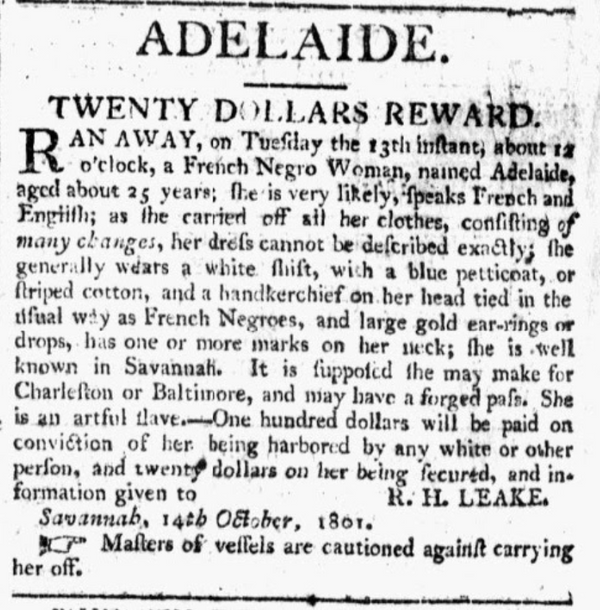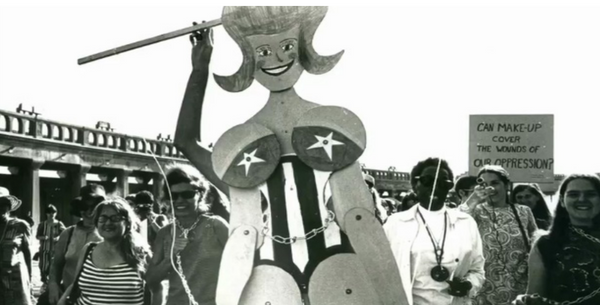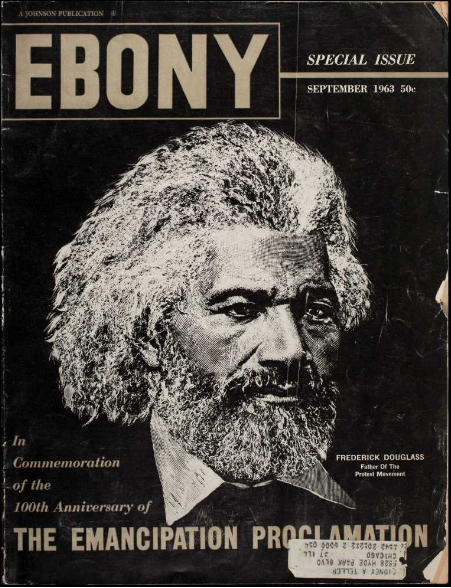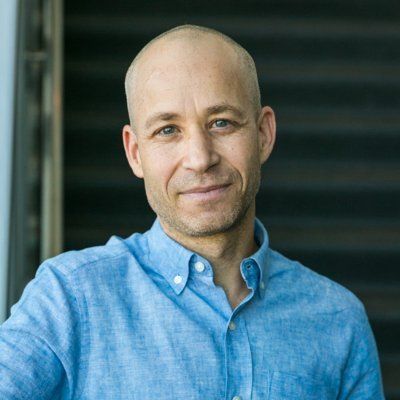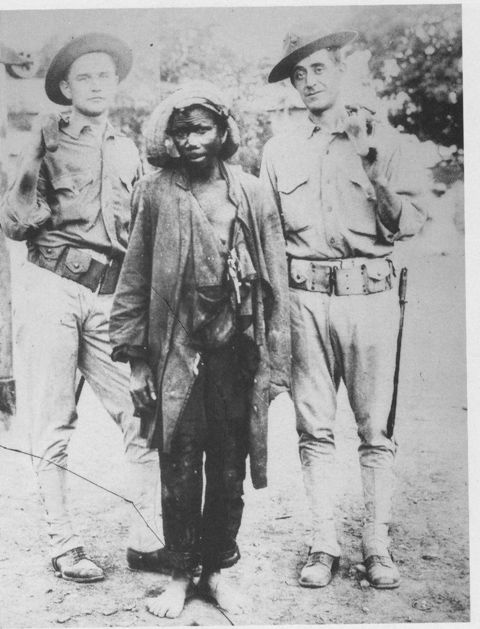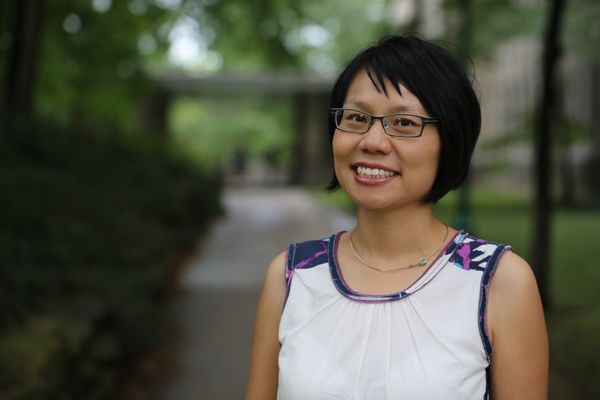By Zoe Bernicchia-Freeman
Edited by Gabby Sevillano '22 and Isabel Kirsch '22
In December of 1845, Dr. James Marion Sims performed his first experimental surgery on an enslaved woman named Lucy.1 Lucy suffered from a severe vaginal fistula which had left a sizable gap between her vagina and bladder. Positioned on all fours, Lucy sat forward on her knees. Her face pointed down towards the floor as Sims exposed her most intimate organs. Twelve of Sims’ male colleagues surrounded him in his backyard hospital in Alabama, observing the operation as if it were an exhibition. Lucy did not receive any anesthesia. To prevent urine from dripping into her vagina, Sims experimentally inserted a small sponge into Lucy’s bladder. Five days later, she nearly died from sepsis. Her urethra and bladder became extremely inflamed; sabulous matter had grown around the sponge, transforming it into stone. Sims ripped the hardened sponge from the neck of her bladder by force. Again, Lucy did not receive any anesthesia. Her agony was so extreme that Sims believed she may die.2 Lucy spent up to three months recovering from the operation. Sims moved on to Betsey, another enslaved woman whom he had acquired for the purposes of medical experimentation. When Betsey’s operation failed, he then moved on to Anarcha. After four years of repeated operations, Dr. James Marion Sims successfully developed a surgical treatment for vesicovaginal fistulas in 1849. His peers celebrated his accomplishments and began referring to him as the “Father of Modern Gynaecology.”3 His discovery went on to alleviate the suffering of countless women.
In 1884, Sims published an autobiography entitled The Story of My Life, which documents his scientific success and failures. However, this work also sheds light on the ethical implications of performing scientific experiments on enslaved individuals. By describing his own inhumane operations, Sims’ account of his work demonstrates the extent to which his patients were dehumanized. The Story of My Life also reflects greater sociopolitical norms of the era; it indirectly explores the complex intersections between issues of slave consent, physical and psychological violence, and biologically rooted racism in the Antebellum South. Moreover, due to the gendered nature of his work, this autobiography also allows for an analysis of Sims’ paternalistic legacy as the “Father of Modern Gynaecology.” Clearly, The Story of My Life is a rich primary source which has inspired numerous historical inquiries. It is also one of the only primary sources available that details Sims’ experimental work. To the knowledge of historians, no reliable evidence has been found to describe how Sims’ enslaved subjects felt about his experiments.
In an attempt to give a voice to Sims’ patients, this work analyses his autobiography alongside independent narratives by other enslaved women who faced sexual violence in the Antebellum South. This is not to imply that one woman’s experiences can or should be interpreted as representative of the experiences of all others. However, this approach prevents the amplification of slaveholder perspectives; rather than shying away from historical topics or events which lack slave narratives, we may instead ponder how surviving perspectives can illuminate those that have been forgotten over time. While this essay takes escaped slave and abolitionist Harriet Jacobs’ narrative as its focus, it should be noted that this comparative approach could be pursued with a variety of other narratives recorded by enslaved women. It is my hope that future historical research will continue drawing insights from these important works.
According to Sims, all of the enslaved women who received experimental operations consented to his work and were even “clamorous” in their demands for more surgeries.4 However, due to a lack of available patient narratives, Sims’ autobiography cannot be accepted as a reliable source regarding the consent of his patients. Parallels can thus be drawn between the possible experiences of Sims’ subjects and the narratives of other enslaved women during the same era. In Incidents in the Life of a Slave Girl, for instance, Harriet Jacobs describes her experiences as a young enslaved woman in the Antebellum South. Since Jacobs’ sociopolitical position is similar to that of Sims’ enslaved patients, her poignant autobiography speaks to many issues that they may have faced as well. In the fifth chapter of her work, “The Trials of Girlhood,” Jacobs describes her complex relationship with her master:
I turned from him with disgust and hatred. But he was my master. I was compelled to live under the same roof with him – where I saw a man forty years my senior daily violating the most sacred commandments of nature. He told me I was his property; that I must be subject to his will in all things. My soul revolted against the mean tyranny. But where could I turn for protection?5
Despite Jacobs’ desire to escape, her status as an enslaved woman forced her into submission. Similarly, Sims’ patients were wholly possessed by their masters; the American Constitution did not grant enslaved individuals any legal bodily autonomy before the Emancipation Proclamation of 1863. Therefore, the conditions of slavery were completely incompatible with the act of consent. Sims even obtained his patients the same way that one may acquire a horse: he conversed with their masters and agreed on terms of exchange.6 If enslaved women did not have legal autonomy over their own bodies, they were clearly powerless to accept or refuse Sims’ experimentation. Nonetheless, dehumanizing ideologies of slavery were so deeply entrenched in the Antebellum South that Sims either failed to understand the impossibility of slave consent or believed that slave owner consent was sufficient.
Sims was not alone in his assumption of slave consent; many of his colleagues and peers in the scientific community supported the existence of this oxymoron. In a eulogy given by William Waring Johnston after Sims’ death, Johnston acknowledges the “willing suffering” of the “humble negro servitors” who patiently endured Sims’ operations in the hope of helping “further his purpose.”7 This odd statement is, once again, completely incompatible with the condition of slavery. In order for slave owners to maximize profit in the Antebellum South, enslaved individuals were to be exploited as mere objects devoid of humanity, and non-human objects do not have the agency to be “willing” or “unwilling” in their behaviour. Even if any of the enslaved women were truly “clamorous” to receive operations, they were still unable to provide any form of genuine legal consent. Durrenda Ojanuga sums up these premises in three simple sentences:
The enslaved women were not asked if they would agree to such an operation as they were totally without any claims to decision-making about their bodies or any other aspect of their lives. Sims used a total of seven enslaved women as experimental subjects; permission was obtained from their masters. They were in no way volunteers for Dr. Sims’s research.8
Ojanuga calls for a conclusive rejection of “willing suffering” and argues that slave consent did not exist. Given the failure of the Constitution to recognize enslaved individuals as autonomous human beings, it is impossible that the recipients of Sims’ experimental surgeries were truly consenting patients.
In The Story of My Life, Sims portrays himself as a selfless doctor who prioritizes the wellbeing of others, but the physical pain suffered by his patients indicates the opposite. As described in the introduction of this essay, for instance, Sims’ operation on an enslaved woman named Lucy proves to be particularly excruciating.9 When Sims decides to leave a sponge in her body after the operation, his removal of the foreign object causes her great agony:
The whole urethra and the neck of the bladder were in a high state of inflammation … There was nothing to do but to pull it away by main force. Lucy’s agony was extreme. She was much prostrated … I thought she was going to die.10
After physically recovering from the experience detailed above, Lucy is repeatedly put under the knife as Sims continues his experimentation. This is only one of numerous examples described in The Story of My Life where enslaved women suffer extreme physical pain at Sims’ hands. He rapidly alternates between women, giving them minimal time to heal between surgeries before operating again. This cyclical schedule leads him to operate on an enslaved woman named Anarcha a total of thirty times – all without anaesthesia, and all within a few years’ time.11 Sims often describes the suffering of his subjects in his autobiography, yet repeatedly asserts that he dedicated his life to alleviating the suffering of human beings. This self-contradiction proves that he clearly did not view enslaved women as human beings.
Since the subjects of Sims’ experimental surgeries were non-consenting and their pain was torturous, they should be referred to as “victims” as well as “patients.” According to Harriet Amos Doss, white women were unable to receive treatment for their fistulas without proper anaesthesia because they supposedly could not endure the pain of such procedures.12 At the time, this observation was used to hypothesize that race and pain threshold were correlated. Now, it serves as an indication of how truly excruciating Sims’ operations were. Free women afflicted with vesicovaginal fistulas could not even withstand a single operation, while Sims’ victims were forced to suffer through dozens. Moreover, Sims writes that vesicovaginal fistulas are not fatal, yet his subjects repeatedly find themselves near death while recovering from his inhumane, repetitive operations.13 Therefore, despite Sims’ self-proclaimed commitment to cure his “patients,” he may have inflicted more pain than the subjects’ fistulas would have ever caused in the first place. This clear violation of the Hippocratic Oath’s basic tenet (“first, do no harm”) did not deter American physicians from celebrating his accomplishments as the “Father of Modern Gynaecology.”14 Sims’ dehumanizing view of enslaved individuals was thus not limited to his backyard hospital in Alabama, but rather reflected the far-reaching ideologies of slavery in the Antebellum South.
In addition to suffering great physical pain, Sims’ subjects were also victims of psychological trauma. As described in this essay’s introduction, Sims stripped his “patients” of their dignity by placing their most intimate organs on display: “the poor girl, on her knees, bore the operation with great heroism … I had about a dozen doctors there to witness the series of experiments that I expected to perform.”15 One can only imagine the intersectional trauma suffered by these women, who were forced to endure insurmountable physical pain under the prying eyes of numerous white male observers. Again, it must be emphasized that Sims’ clients did not receive anesthesia; by remaining awake during their operations, they were made aware of their public degradation.
Moreover, Sims instructed his “patients” to assist with surgery when he did not have enough staff on hand: “I have trained them to assist me in the operations.”16 Therefore, whether they simply held instruments or actively helped Sims operate, the enslaved women were forced to participate in each other’s suffering. According to Doss, Sims used recovering women to hold others down during their operations.17 Since he did not use anaesthesia, restraints were undoubtedly necessary; any kind of thrashing, flinching, or resistance by the subject on the operating table would have hindered his surgical work. In other words, Sims urged his subjects to engage in slave-on-slave violence. One can only imagine the deeply traumatizing experience of being forcibly held down by another enslaved woman or being compelled to facilitate her degradation. This must have been extremely psychologically taxing for a group of women who likely relied on each other to survive; Doss refers to them as a “sisterhood of shared suffering,” as they united in their trauma and cared for each other between gruelling operations.18
It should be stated that Sims did not explicitly acknowledge any intention to humiliate or traumatize his “patients.” However, given the aforementioned evidence, Sims’ physical and psychological abuse was torturous and inhumane – regardless of his personal intentions. If anything, his inability to recognize his own abusive actions reflects the extent to which slave violence was normalized. The degradation of enslaved individuals was not uncommon in the Antebellum South, as psychological violence was often used by slave owners to ensure submission and assert supremacy. In her autobiography, Harriet Jacobs writes: “I know that some [slaves] are too brutalized by slavery to feel the humiliation of their position; but many slaves feel it most acutely and shrink from the memory of it.”19 Jacobs’ account suggests that many of Sims’ victims may have been humiliated and traumatized as a result of slavery in itself. Therefore, the trauma suffered by Sims’ subjects must have been extensive, as they experienced additional public degradation and physical pain resulting from his experimentation. Through Sims’ search to cure vesicovaginal fistulas, his “patients” were physically tortured, psychologically degraded, and forced to participate in each other’s suffering, demonstrating how physical and emotional manifestations of violence against enslaved individuals were often intertwined.
Since vesicovaginal fistulas only affect female reproductive organs, Sims exclusively experimented on women. However, before beginning his experiments, Sims had no interest in gynaecological science; he even stated in The Story of My Life that he “hated investigating the organs of the female pelvis.”20 The motivations behind his change of heart in 1845 must therefore be questioned, as his sudden interest in vesicovaginal fistulas was wildly contradictory to his previous disdain for female reproductive medicine. According to his autobiography, Sims’ fascination with gynaecology began shortly after he first used a medical instrument called a “speculum.”21 This instrument was inserted into the vaginal canal and slowly opened during pelvic exams, which greatly expanded the physician’s field of view.22 Its use was crucial for the diagnosis and treatment of several conditions afflicting the female pelvic organs, as it allowed Sims to closely observe and repair vesicovaginal fistulas. The first time Sims employed a speculum, he was fascinated by his ability to “see everything as no man had ever seen before,” and quickly became convinced that he was on the verge of a groundbreaking discovery.23 Sims’ own description of this initial examination was overwhelmingly self-centred, as he repeatedly affirmed his status as the only man who had ever observed the female pelvis in such detail. Given his previous “hatred” for these same organs, it seems as though Sims only became interested in vesicovaginal fistulas when he realized that a discovery in this field would earn him great repute.
Many academics have argued that Sims viewed the bodies of enslaved women solely as objects to further his own interests. Barron H. Lerner’s argument that Sims “used slave women as guinea pigs to advance his career” serves as a helpful introduction to the intersectional implications of his experiments.24 His assault on Black female bodies was also analysed by Terri Kapsalis, who suggested that Sims perceived himself as a “medical hero” who needed to “traverse” these women’s bodies in his search for “fame, knowledge, and wealth.”25 She even refers to the Black female body as a landscape that white men wished to explore and colonize, which is compatible with Sims’ heightened interest in the speculum.26 It has already been demonstrated above that Sims did not prioritize the wellbeing of his “patients,” but Kapsalis’ work further illuminates the self-fulfilling nature of his objectifying experimentation.
Deirdre Cooper Owens would agree with Lerner and Kapsalis, as her work examines how men have viewed female bodies throughout the history of gynaecological science. According to Owens, Black women were perceived as both superior and inferior to white women, which allowed slave owners to maximize their exploitation:
White medical men tended to write and speak about enslaved black women’s bodies, their fecundity, their alleged hypersexuality, and their physical strength which was supposedly superior to that of white women. At the same time … these men did not map traits such as beauty, humility, patience, and meekness onto black women in slavery. As medical superbodies, sick black women were expected to still perform the duties fit for slaves such as intense agricultural labor and domestic work even while pregnant, infirm, or recovering from illness.27
Owens’ analysis allows us to tackle the ideologies which facilitated Sims’ maltreatment of enslaved women. For instance, the previous owners of Sims’ “patients” only allowed him to experiment on them because their fistulas rendered them useless and “loathsome.”28 Women afflicted with vesicovaginal fistulas lost bladder control and occasionally bowel control, which made manual labor inefficient and limited their childrearing abilities.29 Enslaved women in the Antebellum South were commonly referred to as “breeders,” and those who bore many children received privileges.30 Therefore, Sims was not alone in his objectification of Black female bodies; his experiments were supported by the societal belief that enslaved women were less economically productive if they could not complete certain tasks for their owners (e.g., the production of maximum offspring).
In Medical Bondage: Race, Gender, and the Origins of American Gynecology, Owens discusses how biological science was weaponized to assert supremacy over enslaved bodies. She uses Sims’ experiments to analyse the inconsistencies of “biologically rooted racism,” which ultimately dictated that Black bodies should remain enslaved due to biological differences.31 These differences supposedly rendered Black bodies inferior to white bodies and justified their continued exploitation. However, this premise contradicted itself: if biological differences between Black and white bodies were significant enough to indicate inferiority, how could medical experiments performed on Black bodies be expected to obtain the same results when performed on white bodies? Once Sims successfully pioneered the use of silver wire to suture vaginal tears, he hypothesized that his cure would relieve the widespread suffering of humanity – not just Black women.32 He then went on to apply his procedure to white women, despite only having tested it on enslaved subjects. Interestingly, he did not seem concerned that his discovery may fail when applied to a different race. As Owens posits in her work, the “biological differences” used to justify racist ideologies were only accounted for when white supremacy stood to benefit from their assertion:
Black people were alleged to be biologically distinct from and inferior to white people. This belief, however, had to be put aside when medical work was performed. Southern white physicians knew all too well that a black woman’s vagina and cervix were identical to the vagina and cervix of a white woman.33
Despite being some of the most educated members of American society, top medical professionals and renowned biological scientists seemed to blatantly ignore this inconsistency. Given their intellectual abilities in numerous fields, it is therefore probable that some physicians knowingly exploited enslaved bodies in order to advance their discoveries.34 If this was indeed the case, these doctors prioritized their own self-interests over the suffering of enslaved women, capitalizing on biologically rooted racism for the “greater good” of scientific innovation.
While Sims’ procedures were sensationalized in his autobiography, other lesser-known doctors conducted similar experiments on enslaved individuals, immigrant populations, and individuals affected by poverty.35 Moreover, the grave-robbing of Black cadavers became commonplace in the early 19th-century, as Black bodies were continually exploited for scientific inquiry.36 Repercussions of biologically rooted racism persisted throughout the twentieth century as well. From 1932 to 1972, the United States Public Health Service conducted a study to observe the effects of syphilis.37 During this experiment, African American males with syphilis were informed that they were receiving free health care and treatment – in reality, they were intentionally left untreated by the government for 40 years.38 The exploitation of Black bodies for scientific purposes clearly extended past Sims’ era, as the Emancipation Proclamation failed to eradicate the racist ideologies which facilitated his experiments. In fact, according to Vanessa Northington Gamble, African American distrust of healthcare authorities still lingers today.39 Given the atrocities of Sims’ experimentation, the Tuskegee Syphilis Experiment, and many other historical injustices, this observation is unfortunately unsurprising.
Some academics argue that Sims did not intentionally cause harm but was rather an unfortunate product of his era.40 While the influence of far-reaching social ideologies should never be ignored, simply being a “product of an era” does not excuse Sims’ work. His intentions do not diminish the suffering of his subjects, which he describes in detail in his own autobiography. On the other hand, it would be equally misleading to depict Sims as a mad scientist who acted alone in his abusive exploitation of enslaved bodies. This debate raises a crucial query: how can we analyze historical actors as products of their environment without excusing their actions or denying the impact of individual agency? This question may never be resolved, but Sims’ experimentation can be used nonetheless as a case study to examine the multifaceted expressions of historical violence against enslaved individuals. While the genuine intentions of nineteenth century physicians will never be conclusively known, their work can still be studied to investigate how medical professionals both reflected and perpetuated sociopolitical norms in the Antebellum South.
Owens suggests that referring to Sims’ subjects as the “Mothers of Modern Gynaecology” should be the first of many steps towards acknowledging their suffering and contributions.41 Moving forward, the absence of “patient” narratives remains the largest obstacle for continuing projects in this field. Future research might involve further analysis of pre-existing slave narratives, in order to extrapolate potential experiences that may have been widespread among enslaved women of certain demographics. Inquiring into the treatment of young enslaved women in Alabama during the 1840s and 1850s, for instance, would allow historians to make educated hypotheses about the specific social spaces that Sims’ subjects may have occupied. Regardless of the approach taken, it is clear that the perspectives of enslaved individuals must be prioritized. However, if slave narratives cannot be retrieved, the absence of such evidence should not discourage academics from engaging creatively with specific locations or topics; instead, historians should adopt new approaches which allow for insights to be drawn from other narratives that are currently available. It is only through consistent engagement and discussion that we may work towards uncovering perspectives which have been lost.
Bibliography
Primary Sources
Jacobs, Harriet. Incidents in the Life of a Slave Girl. New York: Open Road Integrated Media, 2016.
Johnston, William Waring. “Remarks by Dr. W. W. Johnston.” Gaillard’s Medical Journal and the American Medical Weekly 37 (1883): 184-185.
Sims, James Marion. The Story of My Life. New York: D. Appleton and Company, 1884.
Secondary Sources
Doss, Harriet Amos. “The Enslaved Women Surgical Patients of J. Marion Sims in Antebellum Alabama: Sisterhood of Shared Suffering.” In Alabama Women: Their Lives and Times, edited by Susan Youngblood Ashmore and Lisa Lindquidst Dorr, 75-89. Athens: University of Georgia Press, 2017.
Gamble, Vanessa Northington. “Under the Shadow of Tuskegee: African Americans and Health Care.” American Journal of Public Health 87, no. 11 (1997): 1773-1778.
Kapsalis, Terri. Public Privates: Performing Gynecology from Both Ends of the Speculum. Durham: Duke University Press, 1997.
Lerner, Barron H. “Scholars Argue Over Legacy of Surgeon Who Was Lionized, Then Vilified.” New York Times, 28 October 2003.
Ojanuga, Durrenda. “The Medical Ethics of the ‘Father of Gynaecology,’ Dr. J. Marion Sims.” Journal of Medical Ethics 19, no. 1 (1993): 28-31.
Owens, Deirdre Cooper. Medical Bondage: Race, Gender, and the Origins of American Gynecology. Athens: University of Georgia Press, 2017.
Savitt, Todd L. “The Use of Blacks for Medical Experimentation and Demonstration in the Old South.” The Journal of Southern History 48, no. 3 (1982): 331-348.
Wasserman, J., M. A. Flannery, and J. M. Clair. “Raising the Ivory Tower: The Production of Knowledge and Distrust of Medicine among African Americans.” Journal of Medical Ethics 33, no. 3 (2007): 177-180.
Websites
U.S. Department of Health and Human Services. “The Tuskegee Timeline.” Accessed May 12, 2020. https://www.cdc.gov/tuskegee/timeline.htm
Endnotes
1. All of the details listed in this introductory paragraph were retrieved from James Marion Sims, The Story of My Life (New York: D. Appleton and Company, 1884), specifically pages 236-237.
2. Sims, The Story of My Life, 238.
3. Durrenda Ojanuga, “The Medical Ethics of the ‘Father of Gynaecology,’ Dr. J. Marion Sims,” Journal of Medical Ethics 19, no. 1 (1993): 29.
4. Sims, The Story of My Life, 243.
5. Harriet Jacobs, Incidents in the Life of a Slave Girl (New York: Open Road Integrated Media, 2016), 29.
6. Sims, The Story of My Life, 236.
7. William Waring Johnston, “Remarks by Dr. W. W. Johnston,” Gaillard’s Medical Journal and the American Medical Weekly 37 (1883): 184.
8. Ojanuga, “The Medical Ethics of the Father of Gynaecology,” 29.
9. Sims, The Story of My Life, 238.
10. Sims, The Story of My Life, 238.
11. Sims, The Story of My Life, 245.
12. Harriet Amos Doss, “The Enslaved Women Surgical Patients of J. Marion Sims in Antebellum Alabama: Sisterhood of Shared Suffering,” in Alabama Women: Their Lives and Times, eds. Susan Youngblood Ashmore and Lisa Lindquist Dorr (Athens: University of Georgia Press, 2017), 83.
13. Sims, The Story of My Life, 238.
14. Ojanuga, “The Medical Ethics of the Father of Gynaecology,” 29.
15. Sims, The Story of My Life, 237.
16. Sims, The Story of My Life, 243.
17. Doss, “The Enslaved Women Surgical Patients of J. Marion Sims in Antebellum Alabama: Sisterhood of Shared Suffering,” 82.
18. Doss, “Sisterhood of Shared Suffering,” 81.
19. Jacobs, Incidents, 30.
20. Sims, The Story of My Life, 231.
21. Sims, The Story of My Life, 235.
22. Sims, The Story of My Life, 235.
23. Sims, The Story of My Life, 234.
24. Barron H. Lerner, “Scholars Argue Over Legacy of Surgeon Who Was Lionized, Then Vilified,” New York Times, 28 Oct. 2003. According to Lerner, this argument was first put forth by Graham J. Barker-Benfield in 1974.
25. Terri Kapsalis, Public Privates (Durham: Duke University Press, 1997), 39.
26. Kapsalis, Public Privates, 39.
27. Deirdre Cooper Owens, Medical Bondage (Athens: University of Georgia Press, 2017), 109.
28. Sims, The Story of My Life, 240.
29. Owens, Medical Bondage, 20.
30. Owens, Medical Bondage, 19.
31. Owens, Medical Bondage, 22.
32. Sims, The Story of My Life, 246.
33. Owens, Medical Bondage, 28.
34. Owens, Medical Bondage, 20.
35. Owens, Medical Bondage, 17.
36. Todd L. Savitt, “The Use of Blacks for Medical Experimentation,” The Journal of Southern History 48, no. 3 (1982): 337.
37. Vanessa Northington Gamble, “Under the Shadow of Tuskegee,” American Journal of Public Health 87, no. 11 (1997): 1773-1778.
38. “The Tuskegee Timeline,” U.S. Department of Health and Human Services, accessed May 12, 2020, https://www.cdc.gov/tuskegee/timeline.htm.
39. Gamble, “Under the Shadow of Tuskegee,” 1773.
40. J. Wasserman, M.A. Flannery and J.M. Clair, “Raising the Ivory Tower,” Journal of Medical Ethics 33, no. 3 (2007): 178.41. Owens, Medical Bondage, 25.

